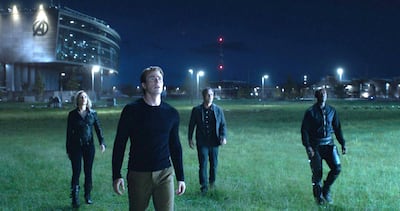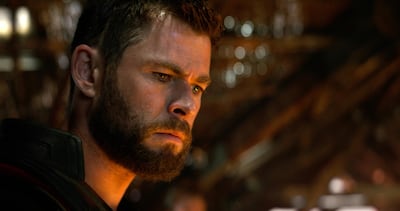"We're in the endgame now." It's Benedict Cumberbatch who says the words. But it's Marvel who means them. The line arrives at the end of last year's Avengers: Infinity War, as Cumberbatch's Doctor Strange and Robert Downey Jr's Iron Man sit battered and on the brink of a catastrophic loss that will, in one of the most audacious blockbuster endings of all time, leave less than half of their team of superheroes alive.
In a classic Marvel move, the line functions as both an Easter egg for fans – the name of Infinity War's feverishly anticipated sequel was hiding in plain sight all along – and a statement of intent.
After 11 years and $18.5 billion (Dh67.96bn) at the box office, Avengers: Endgame, the final instalment of Marvel's extraordinary tapestry of interwoven stories and intertwined characters, marks the finale of the greatest success story in cinema history. And I was there when it started.
From 2006 to 2014, I was editor-in-chief of Empire, a magazine I'm probably still contractually obliged somewhere to remind you is The World's Biggest Movie Magazine. In 2008, there was simply no better place to be. That summer, Indiana Jones was coming out of retirement (he should have stayed there) in Kingdom of the Crystal Skull. Batman was back in The Dark Knight. And 007 was returning once again, in the sub-editor's migraine that was Quantum of Solace.
For magazines like Empire, line-ups like these don't come along often, sure-fire news-stand smashes that have publishers rubbing their hands. Which is maybe why my publisher's hands very nearly ended up wrapped around my neck. "What's this?" he asked, eyes bulging with either fury or fear (it was hard to tell), when I showed him the cover we were running instead of any of those cash cows. "Who the hell is Iron Man?"
To be fair, it was a valid question. Now, it's Marvel's established formula to mix together third-tier superheroes with unlikely talent and watch the magic fly. But a decade ago, this whole shebang sounded nothing short of nuts. Here was a character most of the public had never heard of, from the director of Elf (Jon Favreau), and played by an actor (Robert Downey Jr) whose most recent high-profile gig was 15 months in prison for possession of illegal substances and a handgun. "I felt like I might not get a shot at doing it because of the wreckage of my past," Downey Jr admitted in our Iron Man world exclusive. "Even though it had been long enough in my eyes."
Heck, it wasn't even as if Iron Man was the most obviously commercial Marvel movie of the year; the other one being Edward Norton's The Incredible Hulk, aka the Marvel movie everyone would now quite like to pretend never happened.
Today, every studio is busily digging down the back of the sofa to see what "shared universe" of properties it can cobble together. Some, such as Warner Bros and DC, have struggled to maintain any sort of creative coherence. Others, like Universal's Dark Universe, the much-ballyhooed interlinking of their classic monsters, fell at its first Tom Cruise-fronted hurdle, The Mummy, and was swiftly shuttered – the studio quietly pulling the plug on Angelina Jolie's Bride of Frankenstein and Johnny Depp's Invisible Man.
Conversely, the impact of Iron Man (a movie character I was the first magazine editor anywhere in the world to put on the cover, my ego would like to point out) was seismic, its $585 million worldwide forcing the naysayers to swallow their cynicism.
Come 2010's Iron Man 2, Empire had started its own small movie preview event, on London's South Bank. By coincidence, Downey Jr was in town, for – and I'm not making this up – Bono's birthday, although the actor headed back to Claridge's early with his producer wife, Susan, for room-service sandwiches and to watch his favourite TV show at the time, which was, somewhat ironically, called Banged Up Abroad. That's when I got the call. Downey Jr had heard about our event, and wanted to know whether I'd mind if he popped along with some unseen clips from Iron Man 2? A few hours later I was backstage with him, ready to surprise an audience of only 300 people with the ultimate cameo. As Downey Jr strode on to the stage, the room went bananas. Everyone screamed. Some even started crying. It was like a Beatles gig. That's what the man from Marvel meant to them.
If the Avengers really were the Beatles, then Iron Man would be McCartney to Captain America's (Chris Evans) Lennon. Which makes Thor (Chris Hemsworth) George Harrison and The Hulk (Mark Ruffalo, who replaced Norton in the role) good old Ringo. It was these key characters that Marvel Studios president Kevin Feige – the architect of this incredible ecosystem of long-form storytelling – always planned to use as the foundations for his ridiculously ambitious Marvel Cinematic Universe. First, they would have their own stand-alone movies. Then there would be one with them all together – the biggest-budget superhero experiment ever attempted.
Feige's MCU is an extraordinary achievement, especially when you look at its conception. In 1996, Marvel had in fact filed for bankruptcy, having only kept their comic-book empire afloat by licensing out its best-known characters, such as Spider-Man, the X-Men and the Fantastic Four. The company had even lost the rights to Iron Man; the unloved tin man passed from studio to studio before eventually returning home. Time was running out for Marvel, but a last-ditch plan was forming. The company went to Merrill Lynch and secured a loan of $525m, to make Iron Man and The Incredible Hulk, and thus create their own production arm. The collateral against that loan? The rights to 10 of its biggest properties, including the Avengers, Black Panther, Ant-Man and Doctor Strange. If the gamble worked, Marvel would be king of a brave new world. If it didn't, it'd lose everything.
With great power, of course, comes great responsibility. And the unparalleled world-building Marvel has done since then has more than lived up to its own mantra – most recently with Captain Marvel and Black Panther. The former was female-led, both in front of the camera and behind it, and it's a beautiful and brilliant, billion-dollar blockbuster built on a genuine feminist apotheosis. And in Black Panther – a movie its director, Ryan Coogler, described as being about the hyphen between "African" and "American" – Marvel delivered the first comic-book movie to be nominated for a Best Picture Oscar. More than that, its black crew and cast gave black children everywhere not only a superhero to look up to, but a choice of which one they most wanted to be.
Of all Marvel's success, that's surely the greatest tribute to comic-book writer Stan Lee's creations. His characters often confronted real-world bigotry and always celebrated the power of diversity. His superheroes really could make the world a better place. And now, they are again. Lee died last November, but he had already filmed his cameo for Avengers: Endgame, as he had for every other Marvel movie. With many of the Avengers as we know them saying goodbye in this movie and Feige describing it as the full stop on a story we've been following for more than a decade, it's only right that Lee should be there.
The characters will live on, for sure, with different actors in their suits. As will Lee's legacy. But for now, it's time to say farewell. The endgame is finally here. One last time, let's play.









































